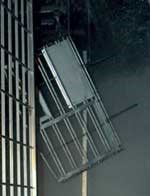Shelf Life
At Thorco Industries—a supplier of point-of-purchase shelves and shelving fixtures—a new pretreatment system is helping to maximize productivity…
When most of us hear the term “shelf life,” we tend to think of canned peaches or Hostess Twinkies®. But at Thorco Industries, the phrase has an entirely different meaning. The Missouri-based company specializes in the design and manufacture of point-of-purchase shelving fixtures for stores like Wal-Mart, Hallmark, Best Buy and Target.
Thorco was founded by Colonel Frank Thorpe in 1899. Originally dubbed F.M. Thorpe Manufacturing Co., the company’s first product was a wire scoop, used for scooping dirty potatoes from burlap bags. In 1966, the company was purchased by James Allen and Kenneth Howard, who provided Thorco with its current name.
Fourteen years ago, Thorco was acquired by the Chicago-based Marmon Group, an international association of more than 100 companies that operate independently within diverse business sectors. At various stages in its history, Thorco’s services and product offerings have expanded.
In its manufacturing processes, Thorco relies primarily on the fabrication of wire, sheet metal and some tubing. Until a few years ago, many of the company’s products were electroplated. However, in an effort to meet customer demand for more colorful products, Thorco made the switch from electroplating to powder coating. Today, all but a small portion of the company’s products are powder coated (a handful of parts are outsourced to a local plating shop).
Thorco employs approximately 600 people in four different facilities. Thorco’s Lamar, Missouri plant is the largest of the four, featuring two 12-gun automatic powder coating lines (from suppliers Nordson and Wagner Industrial Solutions) with manual touch-up for hard-to-reach areas. The company works with as many as 20 colors (provided by Georgia-based TCI Powder Coatings), though a handful of colors account for the large majority of work.
Maximizing Productivity
Like many U.S. manufacturers, Thorco is constantly exploring opportunities for becoming more productive. One such improvement involved how the company stores the components that it purchases from outside vendors. Whereas shelving components—such as brackets, screws, bolts and other widgets—used to be stored in a separate area of the plant, they are now delivered directly to each work cell where those particular components will be used.
Another enhancement that the company has made involves the arrangement of its work cells. Some cells are dedicated to the manufacture of individual, high-volume orders that come in on a regular basis. Others—deemed “flexible cells”—are outfitted with the tools and components necessary to manufacture a variety of racks and shelves with similar designs.
Cross-training also plays a key role in Thorco’s strategy for efficiency. Whereas employees used to specialize on a single aspect of the production process, they have now been trained in a number of different aspects of the production process. As a result, a lone cell might be responsible for four or five aspects of a given production process. For instance, in the welding cells, a single employee is now responsible for several different welding operations.
At Thorco, communication between departments plays a critical role in the company’s overall productivity. If you’ve been in a department store lately, you know that fixtures and display units are becoming increasingly creative and complex. At the same time, customers often lack an understanding of the logistics behind the manufacture of their product. That’s where the company’s design department comes into play. Thorco’s designers work directly with its customers to develop displays that are both aesthetically pleasing and logistically feasible. “There’s a fine line between making the customer happy and at the same time making something that’s friendly to produce,” says Greg Todd, Thorco’s powder line foreman.
Efficiency in Pretreatment
Consistent with Thorco’s efficiency strategy is the company’s recent overhaul of its pretreatment system. Though the company had previously used a three-stage phosphating system with good results, it had concerns about the increasing energy costs associated with it. For assistance, Thorco turned to South Carolina-based Atotech North America, which installed a new three-stage non-phosphate pretreatment system. The stages include a cleaner (which uses Atotech’s UniPrep CC-W), a clear water rinse and a non-chromate sealer (Atotech’s UniPrep PP).
Greg Todd says the results of the change were immediately noticeable. “With [the phosphating system] we were running the temperature at about 150°F. We’re now running it anywhere between 100-120°F.” As a result of the change, Thorco has enjoyed a 36% decrease in its gas usage.
Savings have also been realized in the area of waste treatment. Lacking a waste treatment system of its own, Thorco had to pay for a pollution control service to come in and pump the solution out on a regular basis. In addition to the direct costs associated with the removal of the solution, the process cost Thorco precious man-hours. “We’d have to shut down for two-and-a-half to three shifts, and we were spending a lot of time cleaning nozzles and removing sludge,” says Assistant Plant Superintendant Todd Null.
The UniPrep technology, on the other hand, functions as a bioremediation agent. The cleaning solution provides an environment that is well suited for the growth of microbes. Those microbes consume the oils and greases in the system, decreasing the sludge buildup and treating the solution prior to its being sent on to the local POTW. Though the tanks still need to be cleaned every three to four months, maintenance has become a less monumental task. “Nowadays, we simply pump the solution from the first stage into a holding tank. We’ll then clean the tank, and end up with a five-gallon bucket of sludge. That’s compared to the three 50-gallon drums that we used to have,” says Null, who estimates that the shutdown for cleaning has been reduced to one-half of one shift since the introduction of the new technology.
For Thorco, the bioremediation aspect of the pretreatment system is a perfect fit. The environmentally conscious company has already been proactive when it comes to pollution control. Twenty years ago, when it was plating many of its parts, it was among the first companies to switch from hexavalent chromium to trivalent chromium.
From a qualitative standpoint, Thorco’s management could not be more pleased with the new system. “We did all kinds of impact and adherence tests and we’ve been very satisfied with everything we’ve seen,” says Null. In fact, Null and his associates have been so pleased with the economic and environmental results of the pretreatment system that it has integrated the technology into the other three plants.
Related Content
Adjusting Current and Voltage When Powder Coating
Which manual powder coating gun setting is better to adjust, voltage or current? Jeff Hale of Gema USA discusses when to use different settings on your powder gun to achieve optimal results.
Read MoreAn Altruistic Growth Strategy Puts People First
Professional Plating emphasizes investing in its team and fostering a supportive environment on the shop floor.
Read MorePowder Coating Overcomes Post Forming
Six Sigma methodology, open communication, and collaboration produce results for leading boat manufacturer.
Read More12 Ways to Improve Your Powder Coating Quality
Often overlooked powder coating procedures that can help you elevate your quality, streamline your operations and improve your profitability.
Read MoreRead Next
Episode 45: An Interview with Chandler Mancuso, MacDermid Envio Solutions
Chandler Mancuso, technical director with MacDermid Envio discusses updating your wastewater treatment system and implementing materials recycling solutions to increase efficiencies, control costs and reduce environmental impact.
Read MoreDelivering Increased Benefits to Greenhouse Films
Baystar's Borstar technology is helping customers deliver better, more reliable production methods to greenhouse agriculture.
Read MoreA ‘Clean’ Agenda Offers Unique Presentations in Chicago
The 2024 Parts Cleaning Conference, co-located with the International Manufacturing Technology Show, includes presentations by several speakers who are new to the conference and topics that have not been covered in past editions of this event.
Read More
























